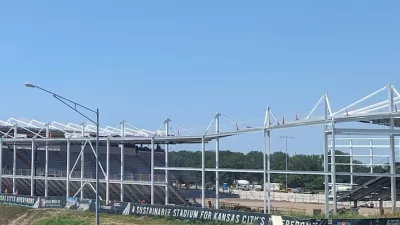Historic and affordable housing tax credits recently came under fire from a Missouri state senator. Kevin Collison, writing for the Kansas City Star, responded.
State Sen. Will Kraus recently told The Star, “We are spending too much on tax credits...And we’re not getting the return on investment that we should be demanding,” referring to historic and affordable housing tax credits.
Kevin Collison then penned a rejoinder, citing specific case studies, including a recently approved project called the Argyle--a 10-story building at the prominent corner of 12th and McGee streets in the heart of downtown, originally designed by one of Kansas City's best known architects, Louis Curtiss.
"For more than 15 years the return on investment in this grand edifice a stone’s throw from City Hall has been zero, nada, nothing," writes Collison. But the deal's $3 million tax credit "will leverage a $20 million deal to develop a relic of Kansas City’s past, convert it to 124 nice apartments, and make it a place where a couple hundred people will live as part of Kansas City’s future. People who will go to bars and restaurants, shop for food and bring that stretch of 12th Street alive."
The coup de grâce of Collison's argument: "The Alliance for Investment, Jobs and Preservation estimates that Missouri has issued $1.35 billion in historic tax credits overall since the program began in 1998. The return on that investment? An estimated $7.25 billion in projects and more than 24,700 housing units created."
FULL STORY: State historic tax credits are a good investment

Maui's Vacation Rental Debate Turns Ugly
Verbal attacks, misinformation campaigns and fistfights plague a high-stakes debate to convert thousands of vacation rentals into long-term housing.

Planetizen Federal Action Tracker
A weekly monitor of how Trump’s orders and actions are impacting planners and planning in America.

In Urban Planning, AI Prompting Could be the New Design Thinking
Creativity has long been key to great urban design. What if we see AI as our new creative partner?

King County Supportive Housing Program Offers Hope for Unhoused Residents
The county is taking a ‘Housing First’ approach that prioritizes getting people into housing, then offering wraparound supportive services.

Researchers Use AI to Get Clearer Picture of US Housing
Analysts are using artificial intelligence to supercharge their research by allowing them to comb through data faster. Though these AI tools can be error prone, they save time and housing researchers are optimistic about the future.

Making Shared Micromobility More Inclusive
Cities and shared mobility system operators can do more to include people with disabilities in planning and operations, per a new report.
Urban Design for Planners 1: Software Tools
This six-course series explores essential urban design concepts using open source software and equips planners with the tools they need to participate fully in the urban design process.
Planning for Universal Design
Learn the tools for implementing Universal Design in planning regulations.
planning NEXT
Appalachian Highlands Housing Partners
Mpact (founded as Rail~Volution)
City of Camden Redevelopment Agency
City of Astoria
City of Portland
City of Laramie





























